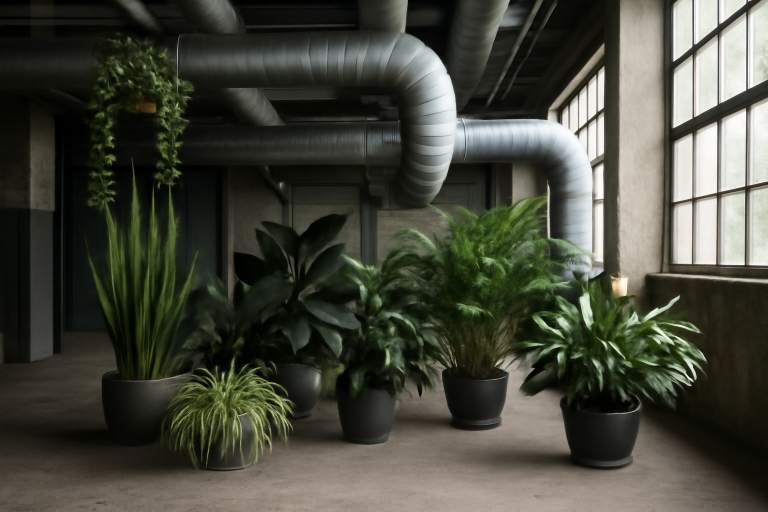The quality of the air we breathe has a direct impact on our health and well-being. In industrial environments, where machinery, chemicals, and high levels of activity can contribute to poor air quality, plants can play a crucial role in mitigating air pollution and improving overall air conditions. In this article, we will explore how plants improve air quality in industrial spaces, the science behind their ability to purify the air, and which plants are best suited for these environments.
1. The Science Behind Air-Purifying Plants
Plants are natural air purifiers. They absorb carbon dioxide and release oxygen through photosynthesis, helping to improve the oxygen levels in the air. But beyond just oxygen production, plants also absorb and filter harmful chemicals from the environment. This process occurs through several mechanisms:
- Absorption of Pollutants: Plants have small openings on their leaves called stomata. Through these pores, plants can absorb pollutants such as carbon monoxide, formaldehyde, benzene, and volatile organic compounds (VOCs). These harmful chemicals, often present in industrial spaces due to chemicals, solvents, or paints, are trapped by the plant and either neutralized or stored within the plant tissue.
- Root System Filtration: The root system of plants can also help filter toxins from the soil. When plants are grown in soil, their roots can absorb contaminants from the ground and help break them down, contributing to the overall improvement of the surrounding air and soil quality.
- Release of Oxygen: Through photosynthesis, plants convert carbon dioxide into oxygen. This process is particularly valuable in industrial spaces where carbon dioxide levels can rise due to human activity and machinery. Increased oxygen levels not only benefit the plants but also improve the health and productivity of employees working in the space.
- Humidity Regulation: Plants release moisture into the air through a process known as transpiration. This helps increase the humidity levels in dry industrial environments, which can improve air quality and prevent respiratory issues caused by dry, stale air. Humidified air can also help alleviate conditions like dry skin and throat irritation.
2. Benefits of Improved Air Quality in Industrial Spaces
Improving air quality through the use of plants in industrial environments can lead to a range of benefits:
- Healthier Workers: Poor air quality in industrial spaces can lead to a variety of health issues, including respiratory problems, headaches, and fatigue. By improving the air quality, plants help reduce the risk of these issues and promote better health among employees. Cleaner air also means fewer sick days and higher productivity.
- Reduced Toxic Exposure: Many industrial spaces deal with chemicals and other pollutants that can negatively impact worker health. Plants help filter out harmful substances, reducing workers’ exposure to toxins and promoting a safer work environment.
- Increased Productivity and Focus: Studies have shown that improving air quality can lead to higher cognitive function, increased concentration, and better overall performance. In industrial workplaces where productivity is key, plants that improve air quality can directly contribute to better work results.
- Improved Mood and Mental Health: Green spaces are known to have a calming effect on people. In industrial environments where noise, stress, and physical labor can take their toll on workers, the presence of plants can provide a calming influence, reduce stress levels, and improve overall mental health.
3. Best Plants for Improving Air Quality in Industrial Spaces
Not all plants are equally effective at purifying the air, so it’s essential to choose the right types for industrial environments. Here are some of the best plants for improving air quality in industrial spaces:
- Snake Plant (Sansevieria trifasciata): The snake plant is one of the most popular air-purifying plants due to its resilience and low-maintenance nature. It thrives in low light, making it ideal for industrial spaces with limited natural sunlight. The snake plant can absorb toxins such as formaldehyde, benzene, and trichloroethylene, improving indoor air quality.
- Spider Plant (Chlorophytum comosum): The spider plant is known for its ability to filter out carbon monoxide and formaldehyde. It’s easy to care for and can adapt to a variety of lighting conditions, making it perfect for industrial environments. Spider plants also propagate quickly, making them an affordable way to add greenery to your space.
- Peace Lily (Spathiphyllum): Peace lilies are excellent at removing airborne toxins such as ammonia, benzene, and formaldehyde. They also help regulate humidity, making them a great choice for industrial spaces where the air may be dry. Peace lilies can tolerate low light but require consistent watering to thrive.
- Aloe Vera: Aloe vera is not only known for its healing properties but also for its ability to purify the air. It can filter out formaldehyde and benzene, two common pollutants in industrial settings. Aloe vera is a hardy plant that thrives in dry conditions, making it an excellent choice for industrial environments with low humidity.
- Areca Palm (Dypsis lutescens): The areca palm is a popular plant for improving air quality, especially in large industrial spaces. It helps filter out xylene and toluene and is effective at humidifying the air. With its attractive feathery fronds, the areca palm also adds a touch of greenery to the industrial landscape.
- Rubber Plant (Ficus elastica): The rubber plant is effective at removing pollutants like formaldehyde and is relatively easy to care for. It does well in medium to bright light and can grow large enough to provide a significant amount of air purification in industrial spaces.
- English Ivy (Hedera helix): English ivy is known for its ability to filter out formaldehyde, benzene, and xylene. It’s a versatile plant that can be used in vertical gardens or hanging baskets. English ivy thrives in cooler environments and can be an effective air purifier in industrial spaces with moderate temperatures.
4. Tips for Maximizing the Benefits of Plants in Industrial Spaces
To ensure that your plants are effective at improving air quality in industrial spaces, follow these tips:
- Choose a Variety of Plants: Different plants purify the air by removing different toxins. By selecting a variety of plants, you can ensure that a wide range of pollutants are filtered from the air.
- Place Plants Strategically: To maximize their air-purifying effects, place plants near sources of pollutants, such as near machinery, chemical storage areas, or high-traffic areas. Make sure to also place plants where they will receive the appropriate amount of light, as this will influence their effectiveness.
- Maintain Healthy Plants: Plants that are unhealthy or stressed may not be as effective at purifying the air. Ensure that your plants receive the right amount of water, light, and nutrients to keep them healthy. Regularly check for pests or diseases that could hinder their growth.
- Consider Plant Size: Larger plants can purify more air than smaller ones. If space allows, consider adding larger plants or even indoor trees to your industrial garden to significantly improve air quality.
- Use Plants in Combination with Other Air Purification Methods: While plants are excellent at improving air quality, they are most effective when combined with other air purification methods such as ventilation systems or air filters.
5. Conclusion
Incorporating plants into industrial spaces is a cost-effective and natural way to improve air quality. Plants not only help purify the air by removing toxins and increasing oxygen levels, but they also provide a range of other benefits, such as improving humidity, reducing stress, and boosting productivity. By selecting the right plants and placing them strategically, industrial businesses can create healthier, more comfortable environments for employees while contributing to sustainability goals.

